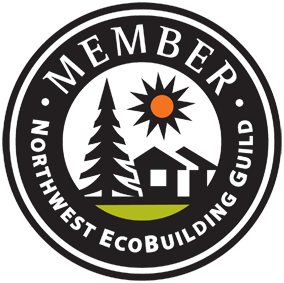Sustainability
We strive to keep abreast of current building practices and methods, that create healthy, comfortable, sustainable environments; those that promote long term stewardship of resource use, and healthy environments.
Considering the entire life-cycle costs of construction, operation, and maintenance is important in all building projects. Green building practices offer an opportunity to create environmentally sound and resource-efficient buildings by using an integrated approach to design. We strive to design structures that promote resource conservation, include energy-efficient equipment, can include energy and water conservation features, minimize construction wastes, reduce maintenance costs, and above all create a healthy and comfortable environment.
Jay has personally been involved in environmental building design for over twenty-five years. He has designed active and passive solar reliant projects, led hands-on workshops, and started an environmental-awareness teaching program in public schools.
His interest in sustainable building practices encompasses concerns for creating healthy environments; whereby exposure to toxic materials, allergens and irritants is reduced, and toxicity of materials is understood and reduced.
Volatile organic compounds, dust, and potentially harmful gases can accumulate inside our homes and buildings, and through understanding the materials we choose, proper ventilation, and design features, we can create comfortable projects for long-term use.
Organizations
Passive House
Jay is a Passive House-certified professional. Passive House is a design methodology  for creating super low-energy buildings. Brought to the US by Katrina Klingenberg, a German architect and educator, PH raises the bar on creating comfortable, healthy buildings that reduce energy requirements substantially.
for creating super low-energy buildings. Brought to the US by Katrina Klingenberg, a German architect and educator, PH raises the bar on creating comfortable, healthy buildings that reduce energy requirements substantially.
In the realm of super energy efficiency, the Passive House presents an intriguing option for new and retrofit construction; in residential, commercial, and institutional projects. A Passive House is a very well-insulated, virtually air-tight building that is primarily heated by passive solar gain and by internal gains from people, electrical equipment, etc. Energy losses are minimized. Any remaining heat demand is provided by an extremely small source.
The Passive House Institute US (PHIUS) is a nonprofit organization that provides training, education and research to promote implementation of Passive House Building Energy standard, as well as the design approach and techniques to accomplish that standard.
Passive House Northwest, in conjunction with PHIUS, provides opportunities to further the concepts and details, through monthly meetings and regional conferences.
Northwest EcoBuilding Guild
The mission of the Northwest EcoBuilding Guild (NWEBG) is to “empower people through education to transform the built environment for long term sustainability.”  The Guild was founded 20 years ago to foster building practices that are self-sustaining, reduce carbon emissions, create optimal conditions for human health and comfort, and contribute to local economies.
The Guild was founded 20 years ago to foster building practices that are self-sustaining, reduce carbon emissions, create optimal conditions for human health and comfort, and contribute to local economies.
The NWEBG is a regional organization. The Seattle chapter sponsors monthly educational events at the Phinney Neighborhood Center. This is a good opportunity to meet other people who are active locally in design and construction, and discuss new ideas and resources.
The organization provides a listing of professional members and services, through the Green Pages Directory. This is a good place to locate designers and builders, who focus on sustainable building practices.
Check out green building resources, articles, and project spotlights on their web site.